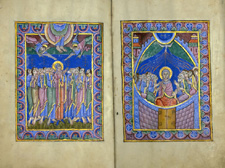Image
© Hildesheim, St Godehard |
THE ASCENSION
Acts 1:9-11
The apostles, with a slightly taller Virgin in the centre, gaze up at
the feet of Christ disappearing into a cloud. On either side of Christ
two angels point vigorously, illustrating the words ‘Ye men of Galilee,
why stand ye gazing up into heaven? This same Jesus which is taken up
from you into heaven, shall so come in like manner as ye have seen him
go into heaven’ (Acts 1:9-11).
Mary is not mentioned in the Bible at the Ascension but she features in
Byzantine and Anglo-Saxon illustrations. However, theologically she is
understood to be the cause of the Ascension through Christ’s incarnation:
‘And no man hath ascended up to heaven, but that he came down from
heaven’, John 3:13 (Deshman, 1997, 523). In the Chludoff Psalter
(Moscow, Historical Museum, add.gr.120) she is shown in profile and in
the Missal of Robert of Jumieges she is in three-quarter view. Schapiro
(1943, 140) identified the image of Christ’s feet disappearing into
a cloud, witnessed from below by the apostles, as a feature deriving from
an Anglo-Saxon homily. In the St Albans Psalter, the same motif is transferred
to Christ’s disappearance from the supper at Emmaus
(p70). (AP, pl 103)
This scene, together with Mary Magdalen’s annunciation to the apostles,
and Mary at Pentecost, shows an important female emphasis in the life
of Christ. This demonstrates both the growing cults of the Virgin and
Magdalen, and the feminine spirituality of Christina whose life mirrored
these scenes. Christina also witnessed Christ’s miraculous disappearance
(Talbot, 1998, 182-9)
Quire 4
Thread or stitch holes for protective curtain

Click
to enlarge
|
![]()